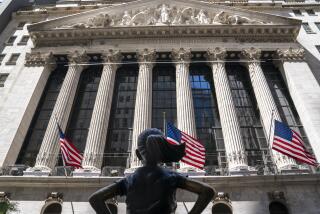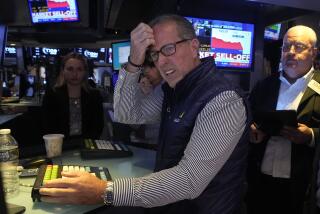‘Contrarianism’ Won Again as Bulls Dwindled
- Share via
Incredible as it seems, almost 70% of the investment newsletter editors tracked by the Investors Intelligence service of New Rochelle, N.Y., accurately predicted the explosive stock market rally that began last week.
That is, they predicted it by not predicting it: Most of the newsletter editors either were outright bearish on stocks or figured that the market’s “correction” would continue a bit longer, according to Investors Intelligence’s weekly survey.
Only 31.9% of the editors were bullish heading into last week--the lowest percentage since December 1994.
Score another victory for “contrarianism,” the investment strategy that entails doing exactly the opposite of what the “experts” advise doing.
The Investors Intelligence survey of 130 investment newsletters nationwide, a feature the service has published since 1963, has proved to be an excellent contrary indicator over the years.
Whenever bullish or bearish sentiment has reached extremes--which in recent years has typically meant when only 20% to 30% of newsletters editors were in one or the other camp--the smart move has often been to side with the minority.
The slide in the bulls’ camp to just 31.9% of newsletters immediately prior to last week, while 42.9% were deeply bearish and 25.2% felt that the market was in an ongoing correction, echoed sentiment in December 1994, according to Investors Intelligence chief Michael Burke.
*
After a year’s worth of Federal Reserve Board-driven interest rate increases in 1994, investors were demoralized and feared many more rate hikes in 1995. The Dow Jones industrial average, which had been pummeled in the spring of 1994, plunged again in November of that year; by mid-December it was hovering around the 3,700 level--and was poised to go much lower, many investment pros believed.
Instead, the stock market rocketed early in 1995, the start of a stunning bull market surge that went on essentially uninterrupted until last summer.
Why does contrarianism work? The simple answer is that the market usually does whatever it has to do to confound the majority of people. Otherwise, investing would be too darn easy.
Practically speaking, too much bullishness may mean that everybody who wants to buy stocks already has. There may not be enough fresh cash around to drive the market higher at that point.
Conversely, too much bearishness may indicate that everybody who wants to sell already has, and that many investors are loaded with money and just waiting for an entry point.
Market veteran Norman G. Fosback, in his classic book “Stock Market Logic,” notes that, “Not unlike private investors, stock market advisors often find themselves caught up in current market trends and unable to yield objective opinions on the likely course of stock prices.”
In other words, emotion gets the best of them and clouds fundamental judgment.
But Fosback, Burke and others who track sentiment of market pros warn that the trends in bullish and bearish opinion always look easier to “play” in hindsight. (Even now, the heavy bearish sentiment of two weeks ago might yet turn out to be an accurate call--if the market’s rally ends abruptly and prices plummet.)
Fosback notes that investment advisors actually “are likely to be right [in their sentiment] during extended market trends,” as they follow along with the direction the market seems to want to go. Indeed, Burke said that bears outnumbered bulls in his survey for most of 1994--so simply jumping into the market at the point the bears began to dominate wouldn’t have been financially lucrative.
*
Instead, Burke said, the sentiment survey is most useful as a market-timing device when either the bull or the bear camp reaches an extreme reading.
But note: The definition of “extreme” also can vary from bull market to bull market and bear market to bear market.
In the horrendous bear market year of 1974, Burke said, more than 60% of newsletter editors were outright bearish for about three months before stock prices finally hit rock bottom. So the majority was right for quite a while.
Likewise, the bulls were in the majority for much of 1995 and 1996, before the market finally went against them last summer.
Investors interested in following Investors Intelligence’s weekly sentiment survey can find the figures in the Business section’s Wall Street, California pages each Tuesday, under the “Stock Market Barometers” chart.
(BEGIN TEXT OF INFOBOX / INFOGRAPHIC)
Upside-Down Indicator
The weekly stock market sentiment survey of 130 investment newsletters by Investors Intelligence continues to show an uncanny ability to predict stock trends----if used as a “contrarian” indicator. Weekly readings of bulls and bears this year:
April 28:
Bulls: 32.2
Bears: 42.4
Note: Newsletter editors who aren’t bullish or bearish are in the “correction” camp, expecting a modest pullback.
Source: Investors Intelligence
More to Read
Inside the business of entertainment
The Wide Shot brings you news, analysis and insights on everything from streaming wars to production — and what it all means for the future.
You may occasionally receive promotional content from the Los Angeles Times.










